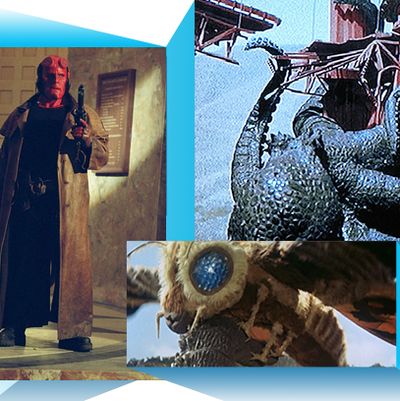
This weekend, as you search for a movie to watch, you can either go out to see some big releases (Grown Ups 2, Pacific Rim), check out some smaller ones (Fruitvale Station), or you can stay home and pick one of approximately 14 billion options available on streaming over a variety of services, be it Netflix, Hulu, Amazon, On Demand, or other sites. Every Friday Vulture tries to make life easier by narrowing it down to a handful of heartily recommended options. This week we trace back the influences of the weekendÔÇÖs big monster movie with an early display of Ray Harryhausen special effects, revisit Guillermo del ToroÔÇÖs Hellboy, and offer a pick for one of the best Godzilla sequels.
Mothra vs. Godzilla
When Pacific Rim director Guillermo del Toro explains what ÔÇ£KaijuÔÇØ means, one name always pop up: Ishir├┤ Honda. After befriending and collaborating with Akira Kurosawa in the thirties, Honda went on to direct 1954ÔÇÖs Godzilla. The man-in-suit disaster movie was an allegorical consideration of war ÔÇö┬áGodzilla was a result of nuclear radiation and a proxy for American forces during World War II. But like all smash hits, it evolved into a franchise, and the fantastical became a priority. This didnÔÇÖt cramp HondaÔÇÖs imagination. For later installments, he ramped up the psychedelic imagery and weaved in new monsters for his reptilian star to battle.
His 1964 film Mothra vs. Godzilla, released in America as Godzilla vs. The Thing, is among the craziest of the bunch. Honda introduced Mothra in a 1961 film of the same name before colliding the characters together for an epic brawl akin to a wrestling match (which explains why we now have live, costumed smackdowns touring the U.S.). Honda is considered a master because he had wonderful timing. He intercut shots of grappling Godzilla with shots of destruction and his rotating cast of dashing reporters, military men, brainy scientists, and in the case of Mothra vs. Godzilla, a pair of pint-size twins who live on MothraÔÇÖs island. What todayÔÇÖs filmmakers do with CGI, Honda did with editing and perspective. Haruo Nakajima, the actor inside the Godzilla suit, was his greatest collaborator. It takes an artist to collapse like a 167-foot lizard. (Available on Hulu Plus, along with a large helping of other Godzilla movies.)
It Came From Beneath the Sea
On May 7, Hollywood said good-bye to visual-effects pioneer Ray Harryhausen, who passed away at the age of 92. Guillermo del Toro dedicated Pacific Rim to the legendary animator and Ishir├┤ Honda. When the stop-motion maestro died, del Toro told EW, ÔÇ£To my generation, and to every generation of monster lovers to come, he will stand above all. Forever. His monsters made millions of lonely children smile and hope for a better world- a world populated by Cyclops and griffons and the children of the Hydra.ÔÇØ
HarryhausenÔÇÖs innovative animation techniques allowed him to create a seemingly limitless number of creature effects, best exemplified in his early film It Came From Beneath the Sea. Working with his longtime producer Charles H. Schneer (who he would partner with on classics like The 7th Voyage of Sinbad and Jason and the Argonauts), Harryhausen was tasked with bringing a giant octopus to life and unleashing it on the poor folks of San Francisco. Skeletal puppetry allowed for his octopus tentaclesÔÇÖ to fluidly flail around the screen, and intricate back projection allowed for the monster to seamlessly interact with the cast. Watching the grand finale of It Came From Beneath the Sea ÔÇö a tussle between the sea beast and flamethrowing soldiers ÔÇö itÔÇÖs easy to see why del Toro fell in love. HarryhausenÔÇÖs creation is just as real as director Robert GordonÔÇÖs cast of human characters. (Available on YouTube.)
Hellboy
Pacific Rim might be del ToroÔÇÖs biggest film to date, but itÔÇÖs not his weirdest. That honor goes to 2004ÔÇÖs Hellboy, the directorÔÇÖs adaptation of comic-book artist Mike MignolaÔÇÖs demonic superhero series. In the film, del Toro cakes his regular collaborator Ron Perlman (Sons of Anarchy) in red makeup to play a humanoid creature from an alternate dimension, brought to Earth by Nazis only to be taken under the wing of a British scientist. When Kroenen, a mystical Nazi Obersturmbannf├╝hrer resurrects himself with magic, itÔÇÖs up to Hellboy, his merman sidekick Abe Sapien, and his fire-slinging girlfriend Liz to put him back in his grave. And we thought this weekendÔÇÖs live-action mecha anime was testing mainstream audiences.
HellboyÔÇÖs scale is the sweet spot for del Toro. While Pacific Rim has an epic weight to it, the comic-book creature feature pushes del Toro to return to the close-combat groove he explored in Blade II. MignolaÔÇÖs source material allows the director to scratch his continuing itch for the odd and macabre, while the design of PerlmansÔÇÖ Hellboy fight choreography and shoot-outs separate it from run-of-the-mill action. Somehow Hellboy steered clear of the studio boardroom and made it to theaters with humor, heart, and a hero who loves kittens and shooting enormous pistols. (Available on Netflix.)

